Tomatoes are one of the best staple vegetables you can ever grow in your home pantry stocking garden. They are the number one vegetable that home growers grow in the USA, and there is a good reason for it. Tomatoes are very heavy-yielding vegetables, versatile, and not that difficult to grow.
To grow tomatoes, you need:
- A sunny location with at least 8 hours of sunshine.
- You can start to grow them from seed or purchase seedlings.
- When choosing a seedling, make sure the seedling appears to be healthy with no spots on leaves or stems.
- Choose a disease-resistant variety to diminish disease issues.
- Plant your tomato in fertile, loamy, well-draining soil after your soil warmed up and the danger of the last frost passed.
- Support a young tomato plant with a stake, tomato cage, or trellis.
- Plant your seedling deeply so that a large part of the stem below the leaves is below the soil for a stronger and more vigorous plant.
- Water regularly with about 1 inch of water per plant, as tomatoes like moist soil and avoid soil moisture to fluctuate.
- Inspect the plant regularly to check for any possible diseases or pests.
- You can harvest tomato fruit when it is of the usable size and color it should be according to its variety.
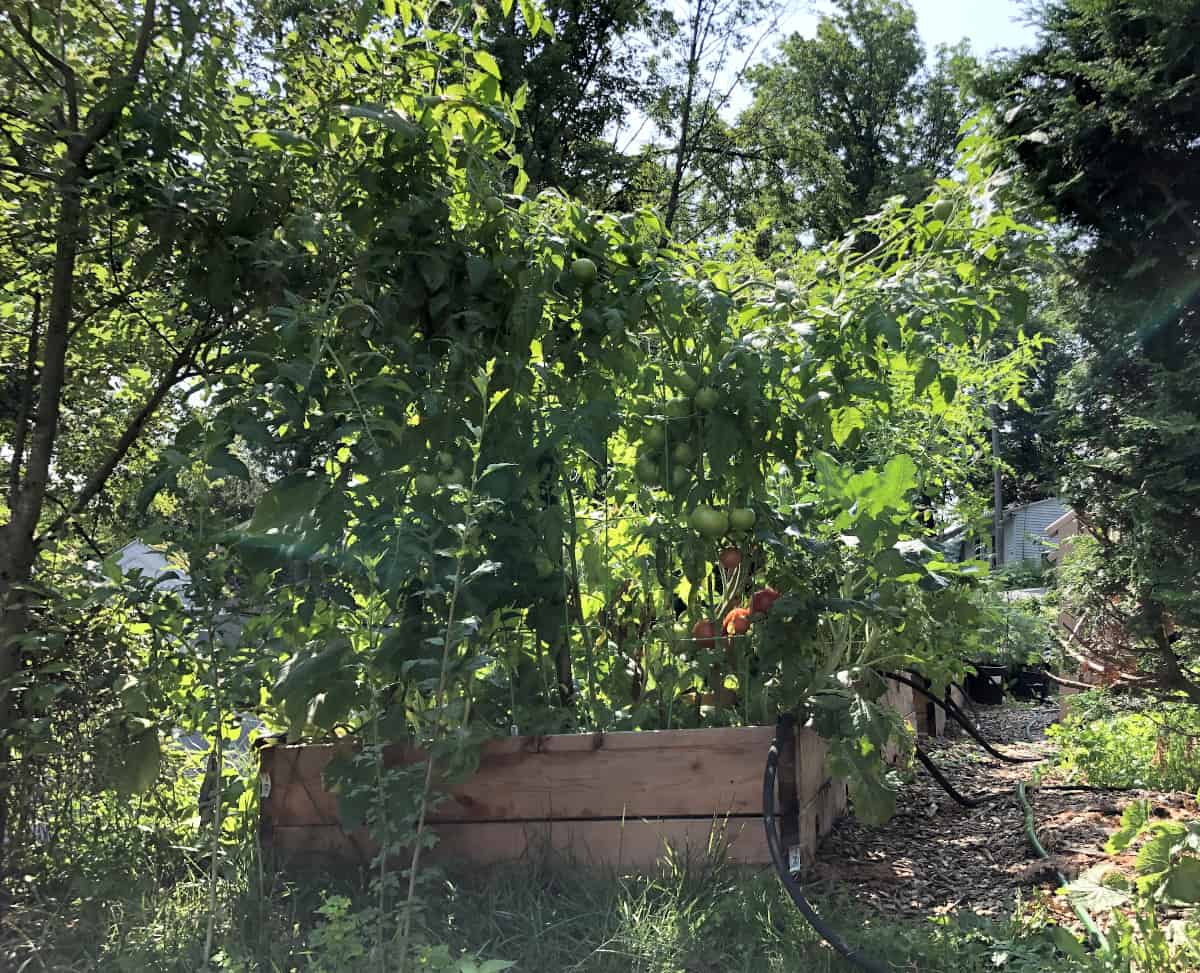
How to select the best location to grow tomato
Tomato is a sun-loving plant. When selecting the best location to grow tomatoes, choose the site that has at least 8+ hours of sun. The soil should be loamy, well-draining, and rich in nutrition. The location should be free of any other nutrition-stealing roots like tree or bush roots.
How to start tomato from seed
Starting tomatoes from seed is not that complicated. You can start growing tomatoes from seed indoors under grow lights or on your sunniest windowsill. Sow your tomato seeds about 5-6 weeks before planting them outside, or before your last frost date.
The best is to start seeds in a seed tray with a transparent plastic dome. That is what I use. Before I purchased seed starting trays, I was creative and used lots of alternatives, but they made me work for it! The containers I came up with either didn’t have a lit and it took quite some time for seeds to sprout since all the heat was lost, or were very clumsy and not as effective, organized and clean to work with. Seed-starting containers with a clear plastic dome are currently the best choice for me to start my seeds in. I can know exactly how many seed trays I can fit under my grow light, it’s easy to work with and I can know exactly how many seeds I can fit in each tray, which helps me be more precise in tracking my seeds and seedlings.
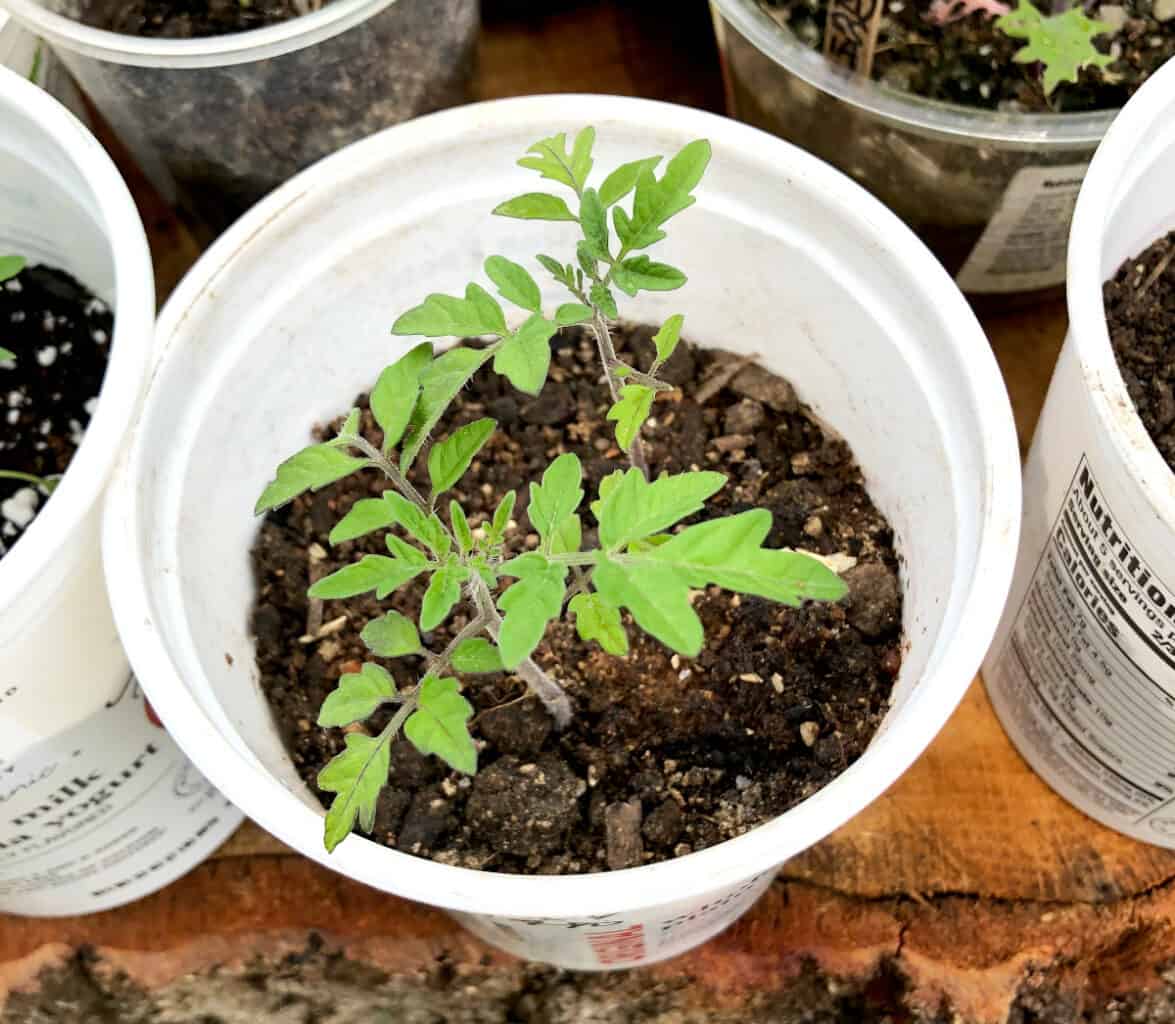
Choose a container in which you will start your tomato seeds. Make sure the container has draining holes on the bottom. You can fill the container with seed-starting mix, homemade compost, or a potting mix. The soil should be moist and quite fluffy, not heavy or too dense.
In general, I prefer to use a potting mix with lots of nutrients to start my seeds, rather than a seed-starting mix, because the seed-starting mix is sterile and doesn’t have any micro-life nor nutrition to provide my young seedlings with.
Using your fingers of a pencil, dig a hole in the soil about one-fourth inch deep and put your seed in. Cover with soil and moisten it using a spray bottle. If you have no spray bottle you can use a water bottle and punch holes in the lid. I used this method before, and it was ok, but nothing can beat a spray bottle. My water bottle with punched holes in the lid mostly created a lot of mess. If you are planting lots of seedlings a spray bottle will be a very helpful tool that will last you years to come.
Cover newly planted seeds with a plastic cover and set them in a warm place. For seeds to germinate they need only warmth and moist environments. They don’t need light yet, so if you plan to grow them under your lights, you don’t have to turn them on during the germinating process, only if you want to increase the soil temperature. After the seeds have sprouted add plenty of light.
The best soil temperature for tomato seeds to sprout is around 70F. I don’t measure soil temperature; I just measure the room temperature and they have sprouted well for me at around 68-70F.
Make sure your soil stays moist and doesn’t go dry when sprouting seeds. Keep the soil moist but not wet.
How to you pick the best tomato seedlings
To pick the best tomato seedlings, for your growing space, the seedling should be well examined and look healthy in appearance. It should have lots of true leaves and should be 3-4 inches tall at the minimum. It should have no spots on the stem and leaves. It should not be wilted or bent and should have no signs of any disease. Look for seedlings that are sturdy, with straight stems. Leaves should be sturdy and green, not yellow, dry, or spotted. Inspect leaves and stem for spots, insects, curling, holes, or diseases.
In general, avoid and pass on seedlings that have very skinny, weak looking, or spindly stems with wilted, yellow, spotted, or curled leaves.
How to plant a tomato seedling?
To plant a tomato seedling is nothing complicated. Let me walk you through this simple process. Once you have yours or purchased seedlings ready for planting, plant them in a sunny location with well-drained and nutritious soil. Plant the seeding deeply, you can even snip the first bottom leaves off to make the stem longer for deeper planting. Tomatoes send roots along the whole stem so they can be planted deeply for more sturdiness. You can plant them 2-3 inches deeper than the depth of the pot they came in.
Once they are planted, water them deeply. Tomatoes like moist soil. If your soil needs more nutrition, you can fertilize your tomato plants using store-bought vegetable fertilizer or compost, homemade compost, or well-aged composted manure such as horse manure, chicken manure, or rabbit manure. I fertilize my garden beds through the winter with trench composting, and topping them with homemade compost. I strive to not add any store-bought fertilizer. When I see that my garden needs some more nutrition, I use chop and drop comfrey, and/or homemade comfrey, weeds, and compost mix liquid extract. I fertilize with store-bought fertilizer only when everything else fails, as I like to be as self-sufficient when gardening as possible.
If you go for a store-bought fertilizer, use the guidance on the packaging. The general rule of thumb is to fertilize tomatoes once every 2 weeks.
How to choose the best tomato variety
Since there is a vast variety of tomatoes, you can easily choose the one that suits your needs the best. To set yourself up for success, choose a variety that is disease resistant. Pick a variety most suitable to your growing space, and how you plan to use your tomato harvest.
There are indeterminate, determinate, and semi-determinate tomato types. Indeterminate grow all season long, they are vining plants and grow very tall and yield a lot of tomatoes. They yield as long as they grow. They can grow into a very tall vining plant that needs extra tall and sturdy support like long stakes or trellis. Indeterminate tomatoes are a great option for gardeners who like not all the harvest come in all at once. Great choice indeed for growers who want tomatoes to be eaten fresh through the whole season as they ripen.
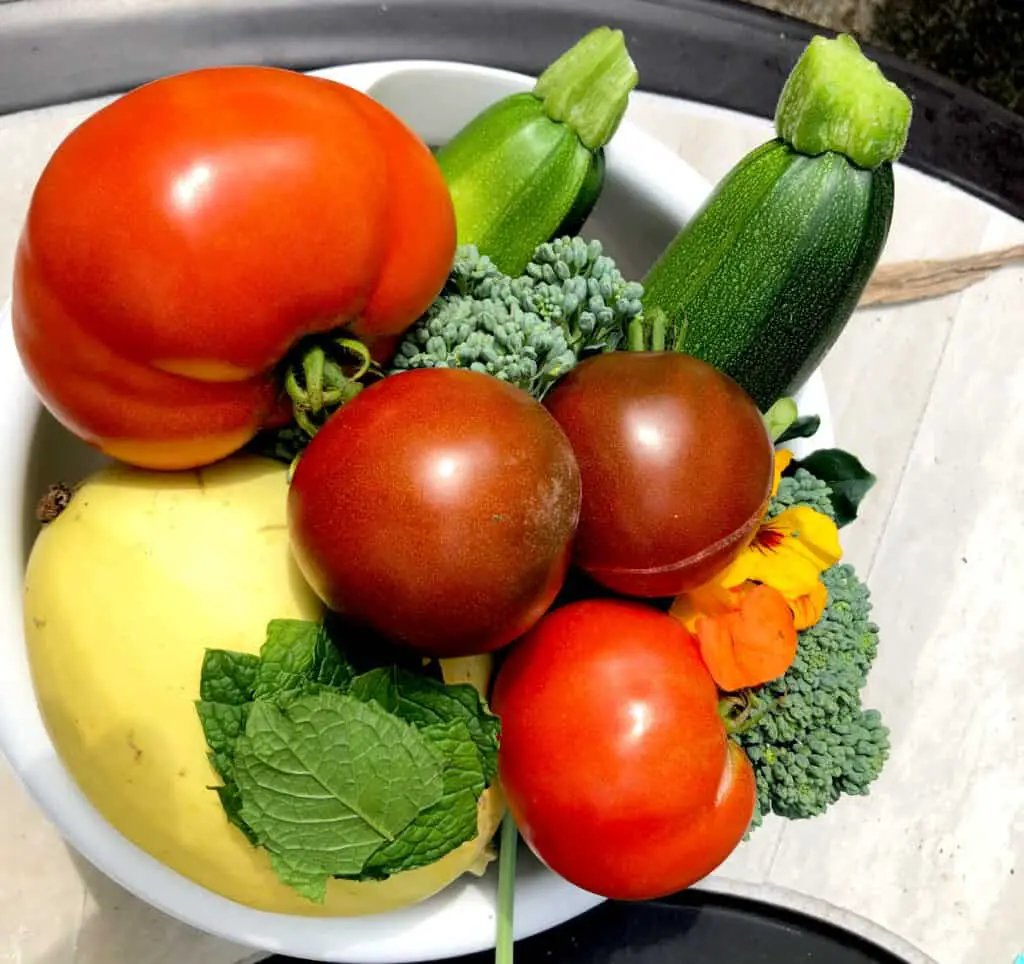
A determinate tomato plant stops growing after reaching a certain height and the majority of its fruit matures within a month or two. The determinate tomato plant is suitable for gardeners with limited space such as container gardening, patio or balcony garden, limited growing season, or for those who want all their tomato harvest ripe at the same time for processing. Determinate tomato plants are busier and need support in form of a tomato cage or stake.
Believe it or not, you can even choose a tomato plant based on the color you want! There are tomatoes that are not only red, but also pink, purple, orange, yellow, and even with stripes! You can choose tomatoes based on your preferred flavor profile. There are tomatoes that are sweet, tart, and tangy.
What tomato is best for a pantry garden
Since tomato is one of the most important fruits to grow in a pantry stocking garden, look into the usage of the tomato you pick. If you aim to fill your pantry with tomato paste, tomato sauce, ketchup, or tomato-based salsa, then pick paste tomatoes which are great for making all kinds of tomato products.
If you desire to grow tomatoes to eat them fresh for salads and sandwiches, then pick large juicy slicing kinds of tomatoes and cherry tomatoes.
Believe me, there is a tomato for every gardener!
TIP: I live in a wet state, we get a lot of average rain even in summer or early autumn when tomatoes ripen. Therefore, when I look for tomatoes to plant in my garden, I go for varieties that don’t crack easily after heavy rainfall. I noticed that purple cherry tomatoes crack easily, and even though I love how they look and taste, I generally avoid them, because from my experience they crack very easily and then go bad quickly. All tomatoes can get affected by too much rainfall but purple cherry especially cracked on me. What is your experience with that? What tomato does well for you during heavy rainfalls?
How to stake a tomato
All tomatoes other than dwarf ones need proper support. You can support your tomatoes using a tomato cage if your tomato is determined and won’t outgrow it. If you grow indeterminate tomatoes that grow over 5 feet tall then they would most probably need to be supported with stakes or a trellis. You might even add some height to your support as your tomato grows.
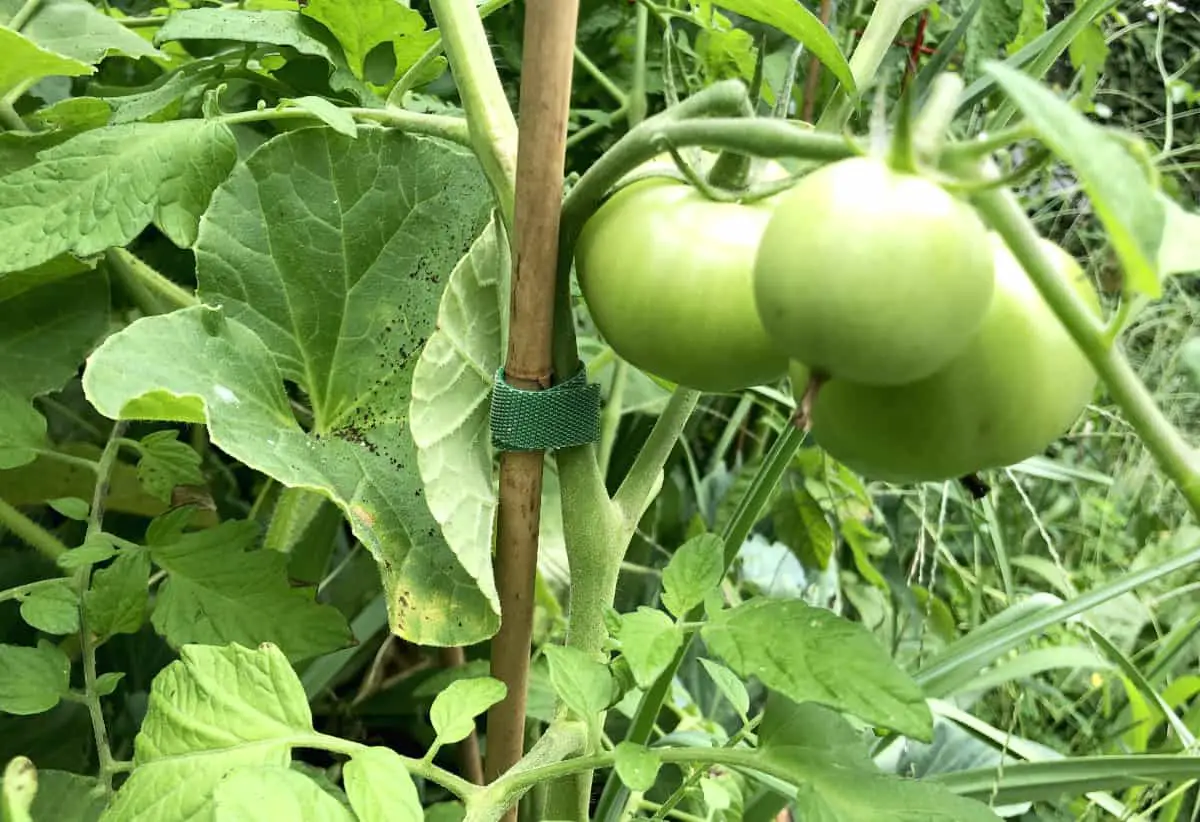
TIP: When my tomatoes outgrow their support, I usually add onto their existing support in height. If adding onto the support height is not possible, I simply let them grow horizontally tying them along my outdoor staircase railing, the nearest tree, or anything really that could give them support especially as the fruit ripens and becomes heavier.
How to protect tomato harvest from pests
Did you know that you might not be the only one waiting for your tomato fruit to reach maturity? There are birds, chipmunks, squirrels, deer, and other pests waiting for the right moment to strike and they are faster than you!
If needed, protect your tomatoes by covering them with mesh covers. I don’t use a mess protector for my tomatoes but I use a motion-activated sprinkler in my garden to protect my garden from larger animals like deer, bears, and raccoons.
Inspect your plants for insect pests regularly. There are some like tomato hornworms or beetles that can be hand-picked off of your plant. If you find insect eggs usually on the bottom of the leaves, simply smash them by hand wearing gloves.
Another way you can protect tomato plants is to plant companion plants around your tomatoes that deter other small pests and insects that would like to inhabit the plant. Herbs are great tiny pest deterrents because they smell bad to them, but great to us. Plant basil, oregano, or thyme to deter whiteflies and other tiny insects.
I don’t usually use pest traps because they can trap bees and other beneficial insects, but if everything else fails and you are out of options, there are pest traps you can use. Sticky traps and pheromone traps are the most common and can be found in any garden supply center.
What is pruning tomatoes and why prune them
Pruning tomatoes simply means removing side shoots from the main stem. There is a main thick stem that goes from the bottom of the plant to the very top and then there are side shoots or side stems that grow out of the main stem. We are not talking about the leaves or leaves stems. The tomato side shoot looks like a new seedling coming out of the main stem.
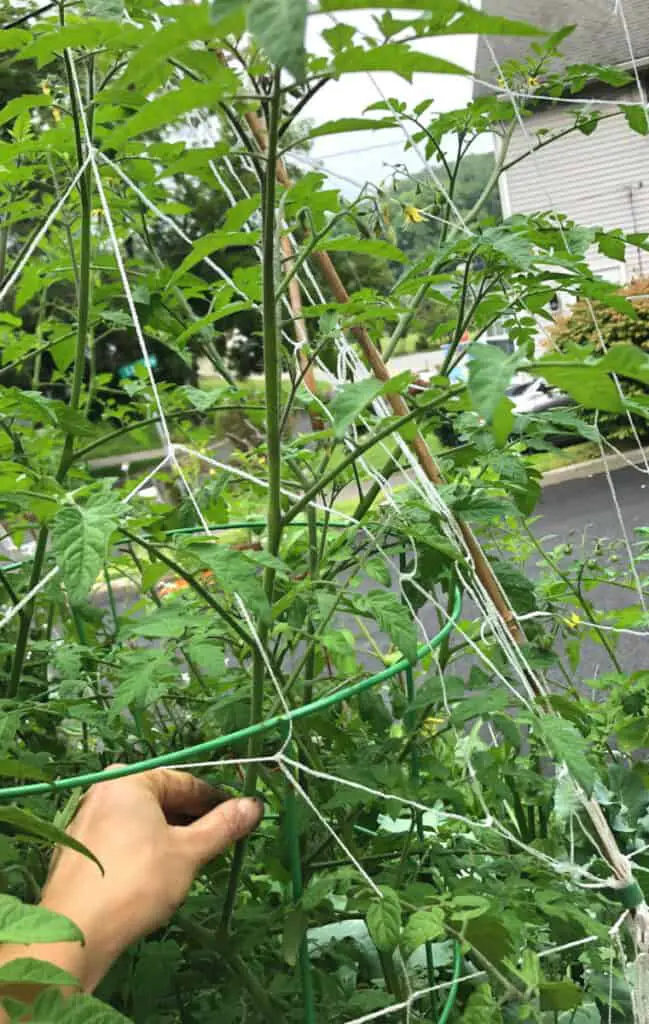
Some gardeners prune or cut off the side shoots to encourage the plant to send all the energy to produce tomato fruit and not waste it on the growth of a new shoot.
I pruned my tomatoes mainly because I had time to do it and I used the side shoots, also called suckers as my seedlings and planted them to have more tomato harvest. I also used them to make fertilizer extract. Thus, suckers were useful to me in this way. My main tomato plant grew very, very tall, so perhaps removing suckers was helpful.
This year, I am planning to experiment and grow one tomato plant with all the suckers left and compare it to another tomato plant of the same kind if there is any difference in fruit production.
I would say, if you don’t have time to prune your tomatoes, don’t worry, you will still have a harvest. If you have time and use to prune the suckers then do it. Tomatoes were grown for centuries pruned and not pruned and both ways the fruit came in. I don’t make a big deal of pruning suckers. If you want to save money and grow tomatoes in succession, then prune the suckers and plant them the way you would plant new tomato seedlings and here you go, you have a free tomato plant with minimal effort!
In general, determined tomato plants don’t need pruning. But many gardeners opt to prune indeterminate tomatoes.
If you have never grown tomatoes in your garden, then I would strongly recommend you give it a try. Tomatoes are high-yield staples, very versatile in our meals, and in reality, not that complicated to grow.
If you have grown tomatoes for years, then please share with me and the readers what tomato is your favorite and even a pantry stocking staple, so we can try it too!
Why to grow tomatoes in pantry stocking garden
Most high-yielding fruits and vegetables to grow in pantry stocking garden

